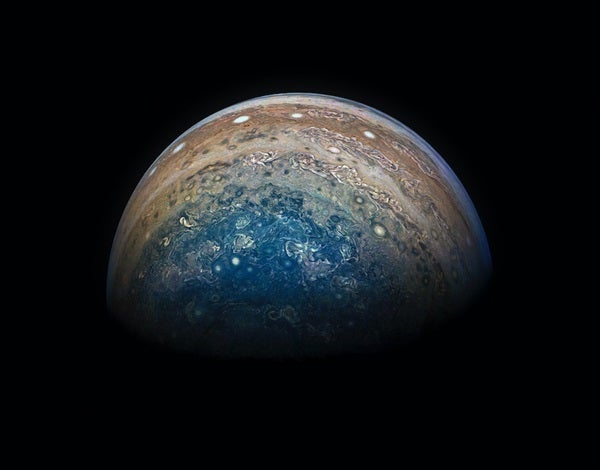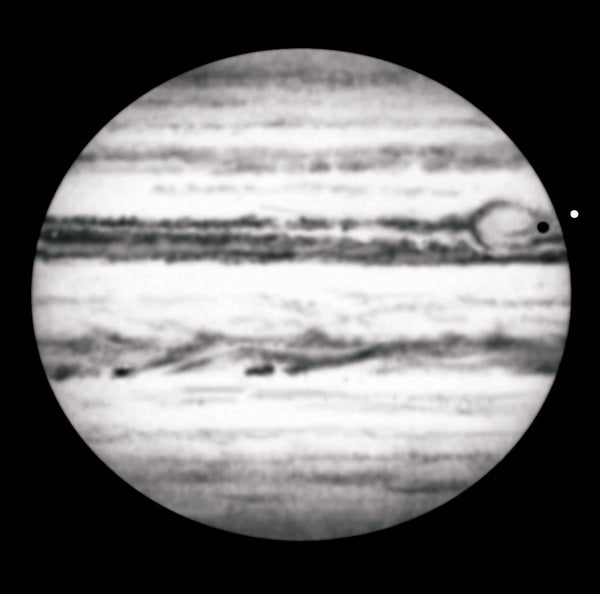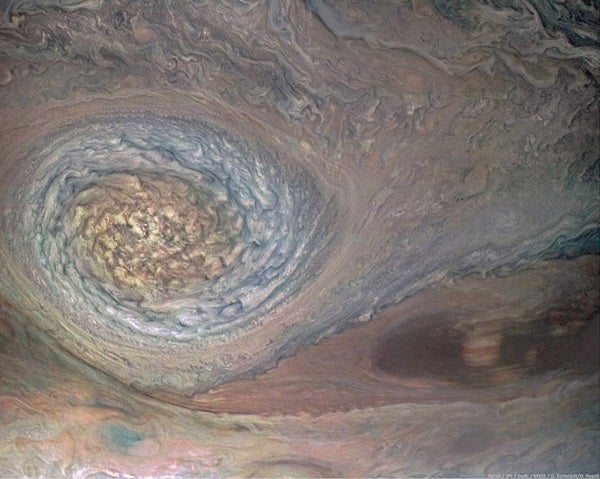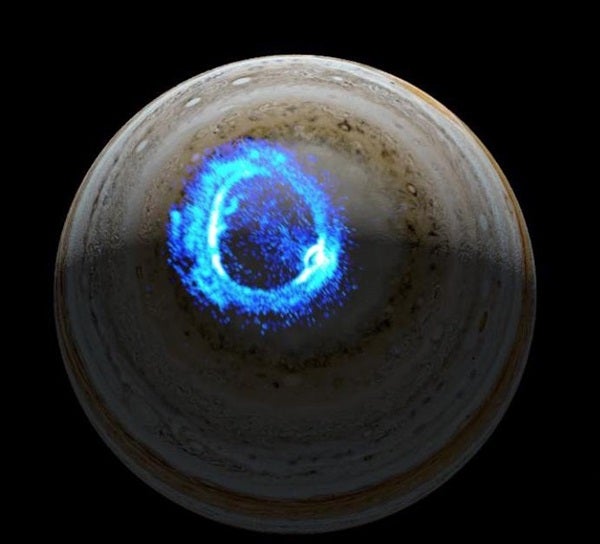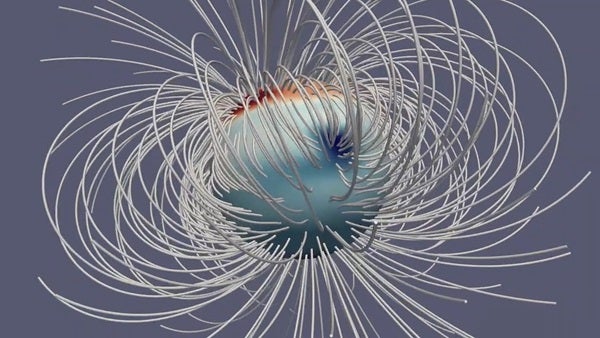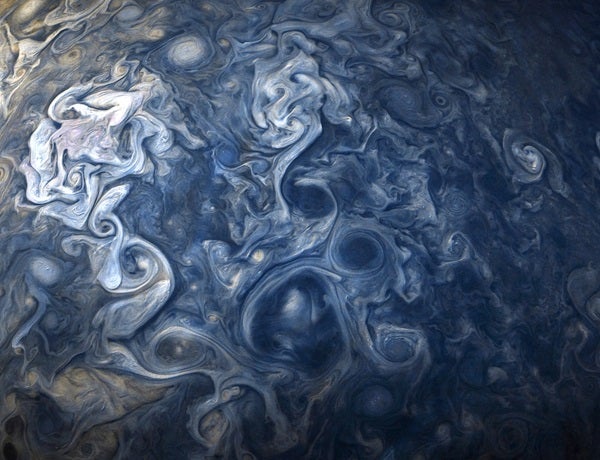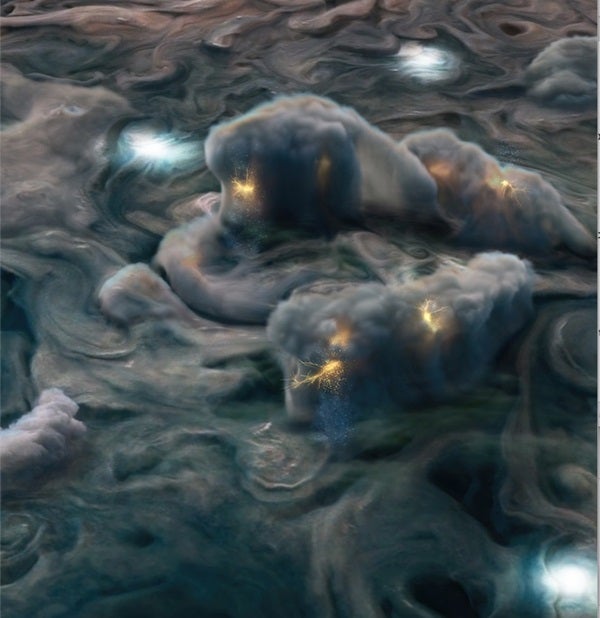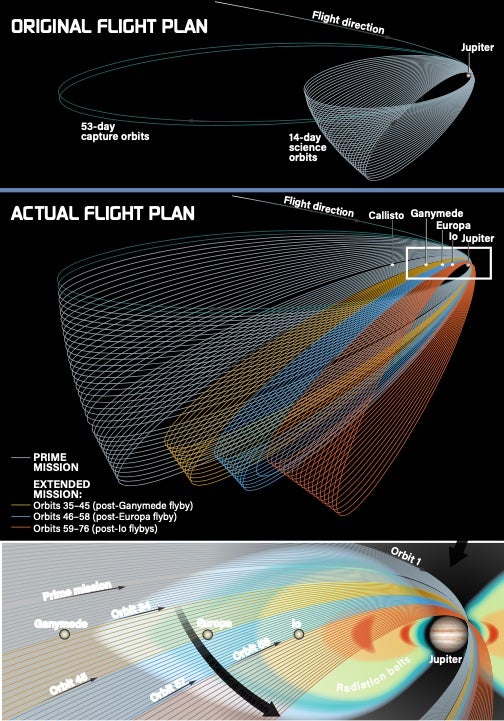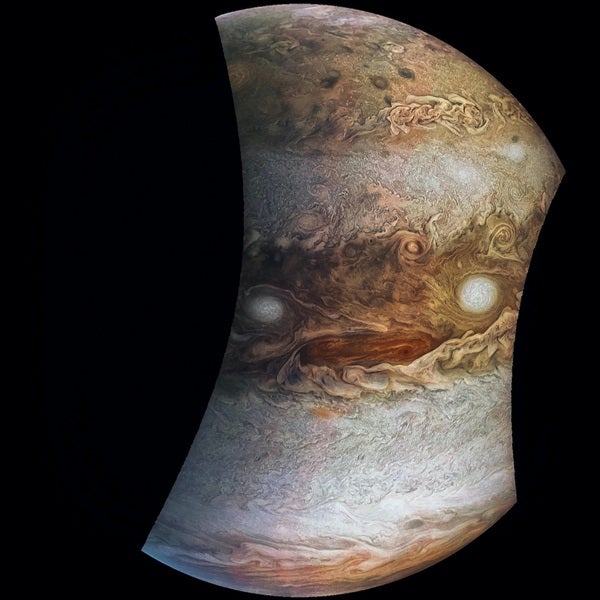Whenever Jupiter, thunderbolt-wielding lord of the gods in ancient Roman myth, misbehaved with the ladies, there was one person he most feared: his long-suffering yet ferocious wife, the goddess Juno. It was said that Jupiter conjured fog to hide his illicit liaisons from his wife. But Juno always saw through her faithless husband’s philandering to reveal his every misdeed.
Like its mythical namesake, the planet Jupiter guards its secrets with jealous pride, its bulk swaddled in thick clouds. For the last six years, though, a spacecraft bearing Juno’s name has watched Jupiter from orbit, stripping away its secrets and furnishing new insights into its interior and evolution.
This robotic Juno has answered many longstanding questions and uncovered new riddles to challenge us. Its onboard camera, JunoCam, has turned Jupiter from a planet into an objet d’art, capturing spectacular planetscapes with sprawling storms. And the craft’s scientific toolkit has made it as much a force to be reckoned with as the goddess herself.
Flying by Jove
The largest and most massive planet in the solar system, Jupiter has been observed since antiquity. But before the invention of the telescope, we knew little of its nature, including its four large Galilean moons (named for their discoverer, the Italian polymath Galileo Galilei) and its most striking atmospheric feature, the roiling Great Red Spot. Our knowledge has multiplied since the dawn of the Space Age, thanks to NASA’s Pioneer, Voyager, and Galileo probes, which surveyed the giant planet between 1973 and 2003.
Juno is the most advanced spacecraft yet to visit Jupiter, brimming with nine science instruments, including infrared and ultraviolet sensors, a radiometer and magnetometer, and energetic particle detectors. For power, it relies on arrays of solar panels — a first for a spacecraft at Jupiter, where sunlight is about 4 percent as strong as at Earth. With its windmill-like trio of 29-foot-long (9 meters) solar arrays fully unfurled, the probe spans about the same area as a basketball court. All previous craft that had voyaged that deep into the solar system relied on nuclear generators. But a worldwide shortage of plutonium-238 nuclear fuel coupled with advances in solar-cell technology made it both necessary and possible for Juno to utilize the Sun’s energy to power itself.
Launched on an Atlas V rocket from Cape Canaveral Aug. 5, 2011, Juno voyaged 1.74 billion miles (2.8 billion kilometers) to reach Jupiter. Its convoluted 59-month trek carried it initially beyond the orbit of Mars, but a pair of maneuvers in August and September 2012 redirected it back past Earth for a gravitational slingshot maneuver in October 2013. This yielded an 8,800-mph (14,000 km/h) speed boost. On July 4, 2016, as Juno hurtled toward its target, a Jupiter Orbit Insertion (JOI) engine burn reduced its speed by 1,200 mph (1,950 km/h), allowing the probe to thread a fine needle between the planet and its radiation belts.
Juno then entered an elliptical orbit not around Jupiter’s equator, but looping from pole to pole. This has given scientists a perspective on Jupiter never seen by the Pioneer and Voyager probes, which made flybys of the jovian system in the 1970s, and even the Galileo mission, which girdled the planet in an equator-hugging orbit from 1995 to 2003.
From this unique vantage point, Juno made the first observations of the planet’s extreme northerly and southerly latitudes. It has also flown more than 10 times closer to its rollicking clouds, raging tempests, and savage radiation belts than any previous mission. In unmasking this multi-hued megaworld, Juno would have made its pansophical namesake proud.
Juno’s initial orbit lasted 53 days, giving engineers time to prepare to test the craft’s instruments during a close passage to Jupiter that August. Then, in October 2016, Juno’s flight plan called for a Period Reduction Maneuver (PRM) to bring Juno in a tighter, 14-day orbit.
Circling Jupiter every two weeks, Juno was expected to have an operational life of just 20 months. The main reason was the intense radiation belts at Jupiter, which had almost cooked the circuits of the earlier Pioneer probes. During their brief flybys, they sustained 1,000 times the human-lethal dose of radiation. NASA expected that Juno would endure the equivalent of over 100 million dental X-rays over its lifetime.
To guard against the onslaught of charged particles funneled by Jupiter’s magnetic field, Juno’s electronics were made with radiation-resistant tantalum, its wiring was wrapped in copper and stainless steel braiding, and its computers were shielded behind the 0.4-inch-thick (1 centimeter) walls of a 500-pound (200 kilograms) titanium vault. “Juno is basically an armored tank going to Jupiter,” said the mission’s principal investigator Scott Bolton of the Southwest Research Institute in a 2010 statement. “Without its protective shield, or radiation vault, Juno’s brain would get fried on the very first pass near Jupiter.”
A flexible flight plan
On Aug. 27, 2016, Juno experienced its first close approach of Jupiter, or perijove, sweeping just 2,600 miles (4,200 km) above Jupiter’s clouds, closer than any spacecraft in history. This flyby provided our first ever high-latitude glimpse of the north pole. It took almost two days to download the 6 megabytes of data from perijove 1, but the results proved well worth the wait. “It’s bluer in color up there than other parts of the planet, and there are a lot of storms,” noted Bolton. “There is no sign of the latitudinal bands or zones and belts that we are used to — this image is hardly recognizable as Jupiter.”
Juno revealed the poles are dominated by densely packed cyclones, all jostling for position. In the north resides a central cyclone, encircled by eight others, all around 2,000 miles (3,200 km) in diameter, as wide as the contiguous U.S. Clinging to the periphery of the pole, as if itching for admission, are other tumultuous weather systems, including a 5,000-mile-wide (8,000 km) behemoth known as the North North Temperate Little Red Spot 1, the third-largest anticyclonic oval storm on Jupiter.
The planet’s deep south proved no less tempestuous, harboring a pentagon of five cyclones around a central sixth. But while the northern storms remained stable over time, scientists were astonished in November 2019 when another cyclone — smaller than the rest, yet still the size of Texas — muscled its way into the southern group. The gatecrasher’s petulance did not go unpunished and within months, it had been pushed out and vanished. To Bolton, “it almost appeared like the polar cyclones were part of a private club that seemed to resist new members.”
As well as spotlighting the storminess of the poles, Juno’s first perijove showed the planet’s magnetic fields and aurorae are much more powerful and extensive than previously thought. It revealed the field is irregularly shaped, lumpy in places, and — at 7.766 Gauss — more than 10 times as powerful as Earth’s magnetic field at its strongest.
But despite a promising start, all was not well. The PRM burn in October 2016 was postponed due to worries about helium valves in the main engine’s pressurization system. Although the valves opened on command, they did so more sluggishly than expected. Matters were compounded further when an unrelated computer reboot threw Juno into safe mode for a few days in late October.
The most efficient time to perform the PRM was during the risky perijove passage, but an increasingly nervous NASA chose to weigh its options before trying again. “There was concern that another engine burn could result in a less-than-desirable orbit,” said Project Manager Rick Nybakken of the Jet Propulsion Laboratory in a statement. “The bottom line is a burn represented a risk to completion of Juno’s science objectives.”
This risk ultimately decided the issue. In February 2017, NASA announced that Juno would remain in its 53-day orbit for the rest of the mission. Researchers did not expect the longer orbit to impair the science, as the probe’s altitude during each perijove would remain the same as it would have during its planned 14-day orbit. Indeed, the 53-day orbit meant that Juno would actually spend less time in the regions of most intensive radiation. “This is significant,” said Bolton, “because radiation has been the main life-limiting factor for Juno.”
Massively magnetic
A bonus of the 53-day orbit was the ability to spend more time in the poorly understood fringes of Jupiter’s magnetic field. Jupiter’s internal magnetism carves a vast cavity into the solar wind, a magnetic realm of influence with a field thousands of times stronger than Earth’s. Researchers inferred its existence with ground-based radio and microwave observations in the 1950s. The Pioneer missions flew through it and the Ulysses probe found that Jupiter’s region of magnetic influence — or magnetosphere — extends about 5 million miles (8 million km) toward the Sun. And the Voyagers showed that the solar wind splays Jupiter’s magnetic field back beyond the planet, forming a magnetotail that extends 460 million miles (750 million km), almost out to Saturn’s orbit.
Later missions also visited Jupiter: In addition to Galileo’s extended stay, Ulysses passed through the planet’s polar magnetosphere during a 1992 flyby and New Horizons traversed 100 million miles (160 million km) along its magnetotail in 2007 while en route to Pluto and the Kuiper Belt. But these were brief encounters. It was left to Juno to undertake the first global mapping campaign.
Mapping the magnetosphere tells us more than just its extent. It’s also one of the few ways to understand Jupiter’s gaseous interior, including its magnetism and core. The planet’s enormous gravity compresses its atmosphere so tightly that it is virtually impenetrable to remote-sensing tools.
Scientists think that beneath Jupiter’s outermost layers of molecular hydrogen resides an electrically conducting shell of liquid metallic hydrogen. The existence of this exotic substance at Jupiter was first proposed in 1951. It has long been thought to play a key role in generating Jupiter’s magnetic field, its rotation acting as a dynamo.
However, the magnetic field’s lumpiness that Juno observed suggested that the field might be created by dynamo effects closer to the planet’s visible surface, above the liquid metallic hydrogen boundary. In May 2019, Juno showed the field changes over time — a phenomenon called secular variation — and its effects are particularly prominent near an anomalous area of magnetism near the equator. As the spot appears blue in maps produced with Juno data, scientists have dubbed it the Great Blue Spot.
Jupiter’s magnetic field is also capable of creating powerful aurorae many times more energetic than Earth’s own. The Voyagers witnessed polar displays spanning 18,000 miles (29,000 km) that were accompanied by whistling radio emissions. Analysis revealed these phenomena were partly triggered by material flowing along magnetic field lines from Jupiter’s volcanic moon, Io.
Juno’s time in Jupiter’s outer magnetosphere yielded an array of discoveries. In September 2017, researchers reported that Juno had found auroral electrons pouring into the atmosphere at energies approaching 400,000 electron volts, 10 times stronger than their counterparts on Earth. Yet, unlike at Earth, they don’t appear to be responsible for the strongest aurorae at Jupiter. This suggests that jovian lights are induced by a form of turbulence in the magnetic field that accelerates charged particles.
More recently, Juno returned the first observations capturing the full birth and evolution of “dawn storms” — intense, short-lived events that regularly appear at sunrise, where the main auroral ovals that circle the planet’s poles broaden and brighten. Juno has also derived insights into Jupiter’s enigmatic X-ray-emitting aurorae and how they may heat the wider atmosphere. And in April 2021, Juno’s ultraviolet spectrograph linked auroral activity on Jupiter for the first time with charged particles at the boundary region between the magnetosphere and the solar wind.
Stormy weather
Juno has also been a prolific storm-chaser, adept at tracking Jupiter’s wild weather. The craft has seen series of Earth-sized cyclones lined up like strings of pearls, and in December 2019, serendipitously witnessed a pair of storms colliding. It watched Jupiter’s second-biggest storm, Oval BA — the result of three spots that merged in 2000 — change color from deep red to almost white in 2015 and 2016. It measured vigorous winds that extend 1,800 miles (2,900 km) deep and shear apart electrically-conducting material in the jovian interior, altering the shape of the planet’s magnetic field. And in 2020, Juno began tracking a small storm found by South African astronomer Clyde Foster, now called Clyde’s Spot.
But of all Jupiter’s storms, none is bigger or longer lasting than the famous Great Red Spot. Continuously observed since the 19th century, it may even be the same storm found by the English scientist Robert Hooke in 1664. The counterclockwise-rotating spot now measures 10,000 miles (16,000 km) in diameter, having noticeably shrunk in recent years. It has also shown dramatic variations in color, morphing from brick-red to its present salmon-pink. In July 2017, Juno flew directly over the spot at a height of just 5,600 miles (9,000 km), spying a tangle of dark, veinous clouds weaving through it.
The probe’s microwave radiometer showed the spot extends further into the atmosphere than its neighboring clouds, penetrating at least 200 miles (320 km) deep. “The Great Red Spot’s roots go 50 to 100 times deeper than Earth’s oceans and are warmer at the base than they are at the top,” said Andrew Ingersoll, a planetary scientist at Caltech, in a statement. “Winds are associated with differences in temperature, and the warmth of the spot’s base explains the ferocious winds we see at the top of the atmosphere.”
Juno has also detected hundreds of lightning discharges that gave off radio waves in the megahertz and gigahertz ranges, far more energetic than Earth’s own. In results reported June 2018, its Waves instrument recorded four lightning strikes every second.
Shallow lightning originating from ammonia-water clouds and giant, slushy hailstones rich in ammonia-ice, known as mushballs, were detailed in research published August 2020. And in October 2020, researchers reported that Juno had found signs of sprites and elves — brief, unpredictable electrical flashes of light associated with thunderstorms — the first to be seen on a world other than our own.
Time extension
While Juno’s mission was originally scheduled to end in 2018, the craft remains so productive that its mission has been extended twice: first to July 2021 and again through September 2025, or until it reaches the end of its life.
These mission extensions have enabled it to take aim not just at Jupiter, but also its large moons Ganymede, Europa, and volcanic Io. One flyby in June 2021 saw Juno pass within just 645 miles (1,038 km) of Ganymede — closer than any spacecraft in a generation — and return spectacular infrared imagery of its icy north pole.
The gravity-assisted tweaks afforded by repeat flybys of these moons in the coming years will naturally reshape Juno’s orbit. Last year’s close Ganymede passage reduced the spacecraft’s orbital period from 53 to 43 days, with a Europa flyby in September 2022 expected to shave this down to 38 days. Two Io encounters, one in December 2023 and a second in February 2024, will cut it further to 33 days.
As a result, Juno’s most remarkable discoveries may be still to come. And a probe expected to survive just two years immersed in Jupiter’s fearsome radiation may spend almost a full decade stripping back the secrets of this most secretive of worlds. “We are not looking for trouble,” promised Scott Bolton. “We are looking for data.” If she could know what her robotic namesake has achieved, the all-seeing Juno of myth would be justly proud. But her philandering husband, surely, would be less than thrilled.
Plotting a course
Juno’s approach trajectory was carefully planned to put the craft into a 53-day polar orbit that avoided Jupiter’s radiation belts and kept its solar panels constantly exposed to sunlight. The original mission plan (top) then called for Juno to tighten its orbit to a 14-day loop that would precess over time, slowly increasing its exposure to the radiation belts. When the mission team decided to cancel that maneuver due to a malfunctioning fuel valve, Juno remained in its 53-day orbit for the duration of its prime mission (middle).
In July 2021, Juno began its extended mission (detailed at bottom) shortly after making a close pass of Ganymede, which reduced the spacecraft’s orbital period from 53 to 43 days. A planned flyby of Europa in September 2022 will further shorten the orbit to 38 days. And two flybys of Io, in December 2023 and February 2024, will trim it to 33 days. The extended mission is approved to last until September 2025.
Junocam’s visual impact
Although all of Juno’s nine instruments have aided the probe’s scientific harvest, it is JunoCam’s spectacular imagery of Jupiter’s swirling surface that has truly resonated in the wider world. The only visible light camera on the spacecraft, JunoCam was conceived not as a scientific instrument, but as a tool for public outreach — and it has been wildly successful.
Members of the public have taken Juno’s raw imagery and reworked it to present different artistic interpretations of Jupiter. One rendition uses two glaring oval storms to create a pair of eyes, which Jason Major called Jovey McJupiterFace (top). Mik Petter used mathematical fractals to recreate Jupiter almost like a petri dish, teeming with organisms. And Rita Najm enhanced the color and contrast of one image to make a beautiful portrait of Jupiter’s clouds, wrapped around each other like the petals of roses.

